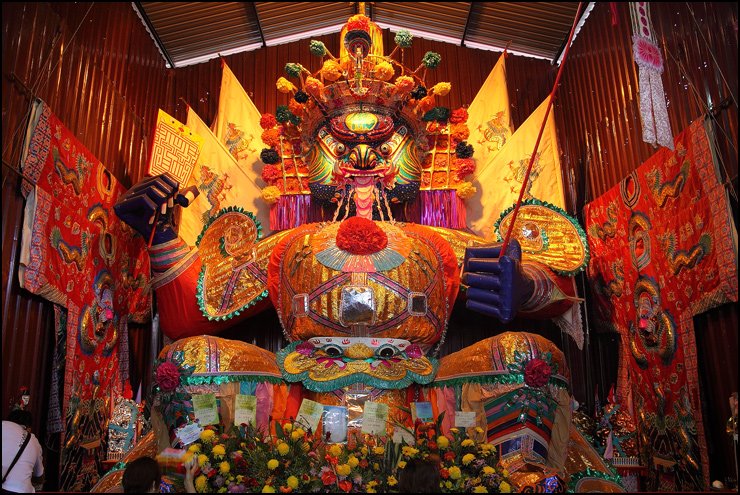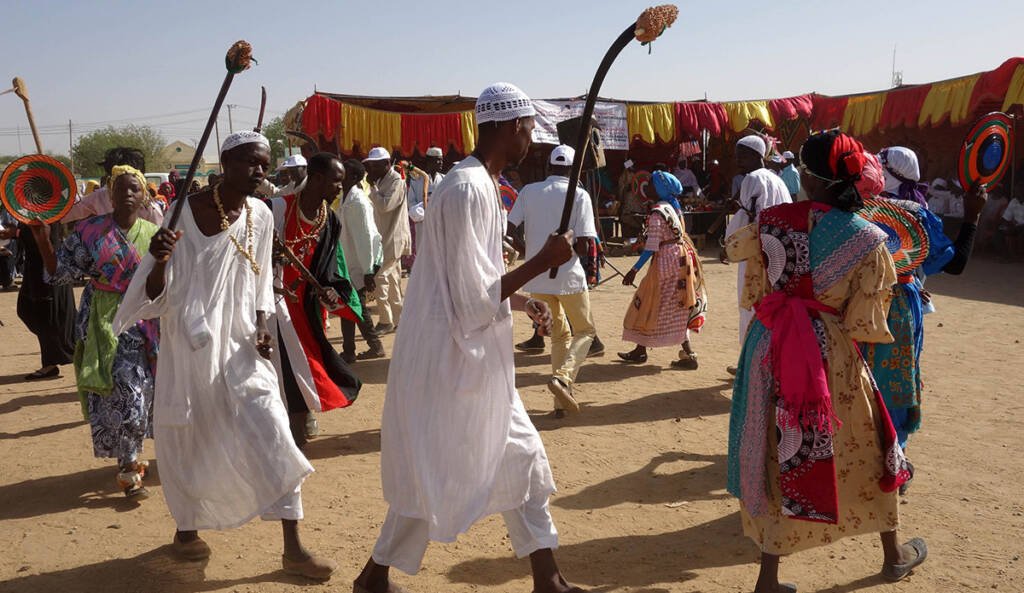Veneration of the Dead

10) Hungry Ghost Festival – is celebrated in Hong Kong on the 15th day of the seventh lunar month, which is around mid-August to mid-September. In several parts of East Asia, people believe that spirits get restless around this time of the year and begin to roam around the world. The festival is a way to “feed” these spirits. It’s part of a larger month-long celebration that also features burning paper and food offerings.
11) Hari Raya Galungan – is celebrated among the Hindu communities of Bali and some other islands of Indonesia. It honours the ancestors who return to visit their former homes during this two-week long festival. It sounds a bit like Mexico’s Dia de los Muertos, but in essence it is more like India’s Diwali, as it similarly celebrates the triumph of Dharma (good) over Adharma (evil). During the celebrations, the islands are decorated with colourful religious votives and offerings of foods, paper money, and flowers are made to deities. The festival occurs every 210 days, calculated according to the Balinese Pawukon calendar.
12) Voodoo – in contrary to the western world, where it is often considered to be extinct, nearly 80 percent of Benin still believe in Voodoo considering it to be very powerful and revered. Almost 10,000 people visit the Ouidah Voodoo festival every year in January, to witness the plays, ceremonies and performances. The delegations of the different Voodoo communities come to the beach, where the festival is held, and pay tribute to the “Pope” of the Voodoo and the most powerful wizards, where animal sacrifices take place which is a common practice in Voodoo. Other common sights are the Zangbetos, whose outfits resemble haystacks, are considered to be the night watchmen entrusted with the maintenance of law and order.

13) Awuru Odo – in Nigeria this festival marks the return of dearly departed friends and family members back to the living. Lasting up to six months, the festival is celebrated with feasts, music, and masks before the dead return to the spirit world. Although the Odo Festival is an important ritual, it happens once every two years, when it is believed, that the spirits would return to Earth.
14) Fête Des Masques – is celebrated every year during the months of April and May by the Dogon people in Mali. It takes place as a memorial of the deceased villagers’ along with celebrating the harvest. Masks, are the most important symbol of Dogon culture, believed to protect against vengeance and help pass on knowledge through the generations. Dancers perform to recount the story of the origin of the Dogon people and although these are now often performed for tourists, they still remain sacred and important to the villagers. Each dancer, representing a different spirit performs, leaping and waving his stick and looking for evil spirits which might prevent the deceased from going to paradise. There are other Fête Des Masques celebrated in the neighbouring countries of Ivory Coast and Burkina Faso.
15) Kakamotobi – also known simply as the Fancy Dress Festival, is an annual masquerade festival held from Christmas to New Year’s Day by the people of Winneba in Ghana. It began almost 100 years ago when Dutch and British colonisers introduced putting on masks and wearing fancy attires to socialise in the coastal towns of Ghana. The people of Winneba adopted and owned this practice by setting up various masquerade troupes, to create elaborate characters and perform with marching bands for their townsfolk. To mark Ghana’s independence, the institution was formalised by Ghana’s first president, Dr. Kwame Nkrumah and now occurs yearly. Although costumes vary greatly many of the more traditional outfits serve as satire and to mock the colonisers.
16) Festival International des Masques et des Arts – celebrated in Burkina Faso is also known as “FESTIMA” which is a biennial festival that celebrates traditional African masks. It was conceptualised in 1996 to help preserve the traditional cultural practices in modern times. The event draws people from all over west Africa, who come to showcase their heritage from over 50 communities, perform dances, acrobats, live music. It is estimated that 100,000 people visit the festival each year with 2,000 of those being international.
17) Ancestor Veneration (pinyin: jìngzǔ) and Ancestor Worship (pinyin: bàizǔ) – in China seek to honour and recollect the actions of the deceased; they represent the ultimate homage to the dead. The importance of paying respect to parents (and elders) lies with the fact that all physical bodily aspects of one’s being were created by one’s parents, who continued to tend to one’s well-being until one was on firm footing. The respect and homage to parents is to return this gracious deed to them in life and after. The Shi (“corpse, personator”) was a Zhou dynasty (1045–256 BCE) sacrificial representative of a dead relative. During a Shi ceremony, the ancestral spirit supposedly enters the personator, who primarily eat and drink sacrificial offerings and convey spiritual messages. Spiritual messages usually were conveyed in the form of Poe divination, to authenticate whether the ancestors have rendered their consent on the messages requested by the divinator.

18) Halloween – on October 31st, people in the United States celebrate Halloween. The word ‘Halloween’ comes from All Hallows Eve which is the day before All Saints Day. Halloween started in Europe and was brought to North America in the 19th century where it became very popular and evolved from its original form. According to tradition, spirits of the dead were apprehended of coming back to life to harm people and crops. People tried to appease the spirits by wearing costumes those which can scare away the harmful spirits, and these practices led to many of the current traditions.
19) Obon Festival – this festival is one of the most important celebrations in Japanese culture. During this three-day festival, the souls of dead ancestors are invited by the living to revisit their homes. Families come together to welcome them by celebrating their life, spirit and legacy. The holiday, which takes place on July 15 or August 15, depending on the region, is joyful with beautiful displays of light, singing and dancing.
Some of the unique traditions that accompany Obon include:
- Obon Lights: On the first day of the festival, it’s common for families to light-up small paper lanterns outside entryways to guide the spirits of ancestors toward their homes.
- Obon Odori Dance: Communities come together to perform the elaborate Obon Odori dance with joyful choreography celebrating their ancestors’ freedom from suffering.
- Grave Visits: Families travel to the resting place of loved ones with a pail of water and ladle for a ritual cleaning of the gravestone. Brushes are used to clear debris on headstones.
- Food Offerings: Special delicacies, known as Ozen, are prepared and shared with the dead. Offerings include fish, rice, tea, fruit and sweet treats usually served on lotus leaves.
In humans, although the mind is strong, it is unstable too, in the sense that the rational frameworks that holds it in place are gone often. All the practices to help the dead are based on a knowledge of the above, with the understanding that although the dead have lost the power to communicate with us, we have by no means lost the power to communicate with them. For one thing, they can hear us. the dead are constantly encouraged and helped to come into focus. Apparently, we don’t even have to speak to them. Thinking of them is like calling their name, so they will be drawn to us. Thus, there is truth in the old injunction, ‘Don’t speak ill of the dead’ because they hear and may be affected by what we say.
This is the first aspect of these death practices; making direct contact with the person and offering guidance, instruction and reassurance. The other aspect is the generation of beneficial spiritual forces to help them. This can be done in many ways and at many levels. Through meditation and reflection, we experience spiritual forces that go beyond the limited confines of the rational cognitive mind that is thinking these words. Whether there is value or benefit in trying to name those forces, I don’t know, but I can say for sure that the common quality that always manifests is compassion. Compassion, like the sun, is an impartial and powerfully healing blessing that shines on all beings, whether they be ‘good’ or ‘bad’ and whether they believe in it or not.
Compassion is expressed through the discerning ability to help in an appropriate manner. It manifests as an all-embracing caring that arises within the mind, a caring that sees all forms of life and beings as equal. It can arise only in a mind that is open and accepting of itself and others; a mind that is not stifled by preferences, judgments, intolerance, self-absorption.

Writer Suvro Sanyal
The writer has drawn inspirations from a friend & philosopher, Rajkumar Dhar, who is a former civil servant. Rajkumar had opted out of the services in order to pursue his ancestral pharmacy services. The writer humbly expresses his gratitude to him…….
Log on : www.mavericknews30.com
Follows us on : Twitter @mavericknews30
YouTube : @MarvickNews30
Your Legal Rights When a Flight Is Delayed or Cancelled in India
New Delhi, Dec 5: With widespread flight disruptions continuing to affect air travel acros…




















